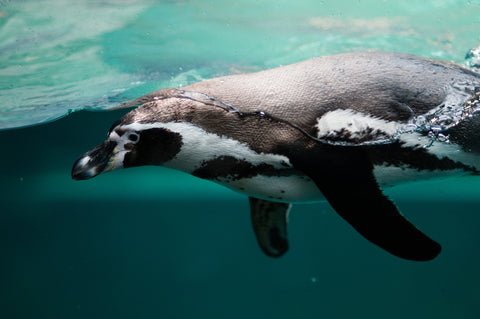All About Penguins
While most believe all penguins look the same and live in the arctic, there is actually so much to learn about them and their unique features. We took a look to learn a little bit more about what makes penguins specially adapted to their environments, what is causing population numbers to drop, and how we can help be a part of the solution to make sure they are around for years to come.
Black and White and Blubber All Over

There are 18 different species of penguins that all live ALMOST exclusively below the equator. Most of them, including emperor, adélie, chinstrap, and gentoo penguins all reside in and around frigid Antarctica. However, there are also penguins found on the Galapagos Islands off the coast of Ecuador, South Africa, New Zealand, Australia, Peru and Chile. The most northerly penguins are Galapagos penguins (Spheniscus mendiculus), who occasionally poke their heads north of the equator.

While they all vary in shape and size, they all have their own versions of black bodies with white bellies. However, this coloration has more purpose than just making them look like a fancy bird wearing a tuxedo. It is called countershading, and it’s an adaptation that many other marine life and animals such as whales, sharks, deer, and honey badgers have developed. German and U.S. military planes also used countershading to hide from their enemies by painting the bottom of the plane white and the top of the plane to match the color of the surrounding area. For penguins, it comes in handy when they are swimming. The black on their backs helps them blend in with the darkness of the ocean from predators viewing from above, and their white bellies help them blend in with the bright surface of the ocean when viewed by predators and prey from below.

Penguins may not soar through the skies, but they have evolved for their own version of flying underwater. Most other birds that fly have hollow, air-filled bones to help them stay light. Penguins have adapted solid bones to reduce buoyancy and help them swim.

Even though they look nice and slick, penguins are covered in a thick layer of blubber, as well as lots of dense feathers to keep them warm even in the coldest of temperatures. A gland near the base of their tail provides waterproof oil. Penguins spend several hours each day covering their feathers with this oil and give extra attention to the task before swimming.

Unlike other birds that shed a few feathers at a time, penguins go through a process called a catastrophic molt. During this time they lose all their feathers at once! They have to condense the molting process into a few weeks because while it is happening, they aren’t able to hunt without their waterproof feathers.

Penguins are carnivores. They spend most of their days in the water looking for food like krill, squid, fish, and crabs. Their sleek body and waterproof feathers allow them to move effortlessly through the water. They average between 5 to 15 miles an hour, but the fastest penguin, the gentoo penguin (Pygoscelis papua), can reach top speeds of 22 miles per hour!

Contrary to many popular holiday cartoons, you’ll never see penguins and polar bears together in the wild. That’s because penguins live south of the equator while polar bears north of the equator in the Arctic!
 A group of penguins in the water is called a raft but on land they’re called a waddle!
A group of penguins in the water is called a raft but on land they’re called a waddle!
Penguins in Peril
Thanks to the Antarctic Treaty that was signed by 12 nations in 1959 and then reauthorized in 1991, Antarctica and its living resources are under protection. As of now, all 18 species of penguins are legally protected from hunting and egg collecting. Every penguin specimen collected with a permit must be approved by and reported to the Scientific Committee for Antarctic Research (SCAR).

Of the penguin species, the most endangered is New Zealand’s yellow-eyed penguin (Megadyptes antipodes), with only around 4,000 birds in the wild today. Other species are in trouble too, including the erect-crested penguin (Eudyptes sclateri) of New Zealand, which has lost approximately 70 percent of its population over the past 20 years, and the Galapagos penguin, which has lost more than 50 percent of their population since the 1970s.

Among the biggest threats to penguin populations is climate change. Species depend on sea ice for access to food and for places to breed, and the warming temperatures in the polar regions is causing sea ice to melt. Rapidly changing conditions mean penguins in places like Antarctica could lose most of their population by the end of the century. A 2008 WWF study estimated that 50% of the emperor penguins and 75% of the Adelie penguins will likely decline or disappear if global average temperatures rise above pre-industrial levels by just 2 degrees C—a scenario that could be reached in less than 40 years.

Another factor is bycatch. Not only does commercial fishing in the Southern Ocean region force many penguin species to compete for the fish they eat, but the practice can also lead to accidental capture and drowning of penguins and other marine life in fishing nets.
How You Can Help Penguins
There are many opportunities to help penguins and other species that share their ecosystems. One of the easiest, and we think most fun ways, is to support your local zoo or aquarium. Most people do not have the opportunity to observe penguins in the wild. The unique ability to observe and learn directly from live animals increases public awareness and appreciation of wildlife, and many of these facilities are donating their time, energy, and money to conservation all over the world. The Species Survival Plan (SSP) is a captive propagation and management program to preserve, in zoos and aquariums, selected species - most of which are threatened or endangered in the wild. Association of Zoos and Aquariums (AZA) Wildlife Conservation Management Committee (WCMC) has designated an SSP for Humboldt penguins.

If you eat seafood, choose seafood that is certified by the Marine Stewardship Council or Aquaculture Certification Council. Eating sustainable seafood will reduce the amount of accidental deaths due to entanglement in fishing gear and ensure that penguins and other ocean animals can find enough food to eat.

Other easy ways you can help penguins and wildlife alike include unplugging appliances when not in use including power cords, lights, TV, gaming systems, and computers. Not only will this save energy but also save you money.

You can also plant a tree. Plants, especially trees help to soak up carbon dioxide in the atmosphere and therefore reduce carbon emissions and greenhouse gases naturally. Plus who doesn’t love gorgeous greenery and the local wildlife will appreciate it as well.
Let us know anything you learned and your favorite things about penguins in the comments below. Be sure to check out our Facebook and Instagram for more fun animal facts and deals we have in our store, then visit our Wildlife Guardians Facebook group for like-minded people wanting to share and learn more about how to live more sustainably and support a work where all things can thrive.
